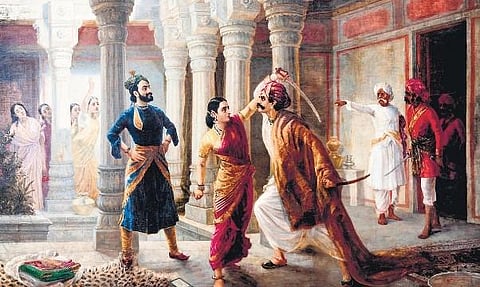

CHENNAI: When Ganesh Shivaswamy was diagnosed with pituitary cancer at the age of 16 in the ’90s, he was told that the tumor might cause him to permanently lose one of his eyes. While he was undergoing chemotherapy to fight cancer, he didn’t have many options medically to save his eye. So, when one of the doctors suggested he start looking at art to stimulate his optic nerves, he was quite irked. “Dr RM Varma, whose care I was placed under, explained that our sense of vision is quite powerful and responsive to external stimuli.
He felt that we should try something out of the box in order to save my eye,” says Shivaswamy, who then started to collect lithographs of paintings by renowned artist Raja Ravi Varma. Nearly three decades later, Shivaswamy, a practicing lawyer has released a book The Shaping of the Artist (Rs 4,500, White Falcon Publishers), the first of a six-part series, where he explores the life and works of Ravi Varma.
“The scale of the entire project is huge with over 1,70,000 words spanning six books. It’s an expansive behind-the-scenes insight into Ravi Varma’s processes and how each of his artworks came to be,” Shivaswamy says, adding “Most of Ravi Varma’s works are spoken about in isolation. I have tried to put his works in a larger context, answering questions such as, ‘What were his influences?’, ‘Who were his models?’, ‘Did he use photography to stage his paintings?’ and more.”
While in search of answers to those questions, Shivaswamy also made some surprising discoveries. “I saw a whole box of negatives sitting at Kilimanoor Palace and when I scanned them, I saw someone posing as Damayanti. When I took a closer look, I realised it was Ravi Varma himself wearing a sari and posing on a stool,” Shivaswamy shares. Ravi Varma is easily one of the most well-known artistic names in the country and his contribution to the art world is well documented.
But Shivaswamy says Ravi Varma’s role in democratising religion for scores of Indians is often less talked about. “When the lithograph of his painting of Lakshmi was made available to the public in the 1890s, suddenly a lot of people who didn’t have access to temples could worship the goddess at their homes. We have to remember that not until another four decades later did social reforms allow everyone access to temples,” he says, adding “With this book, everyone will know where the images of gods and goddesses that they have grown up worshipping came from and how they were created.”